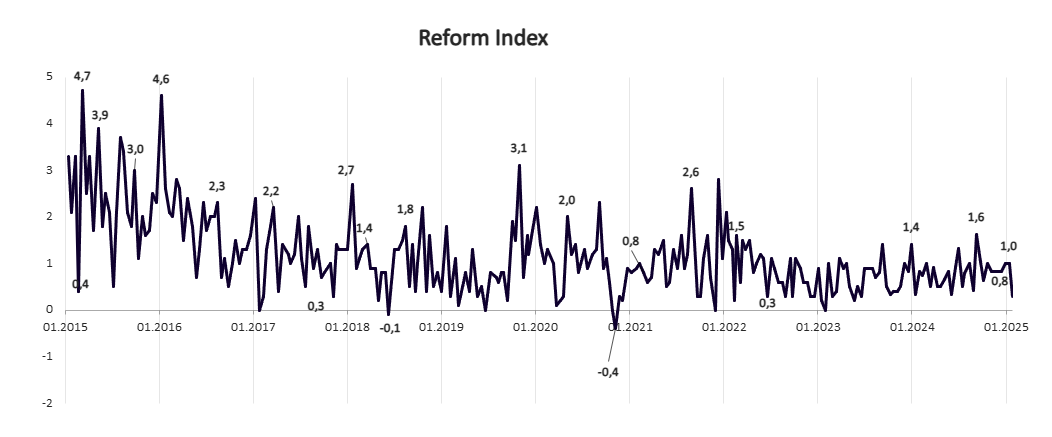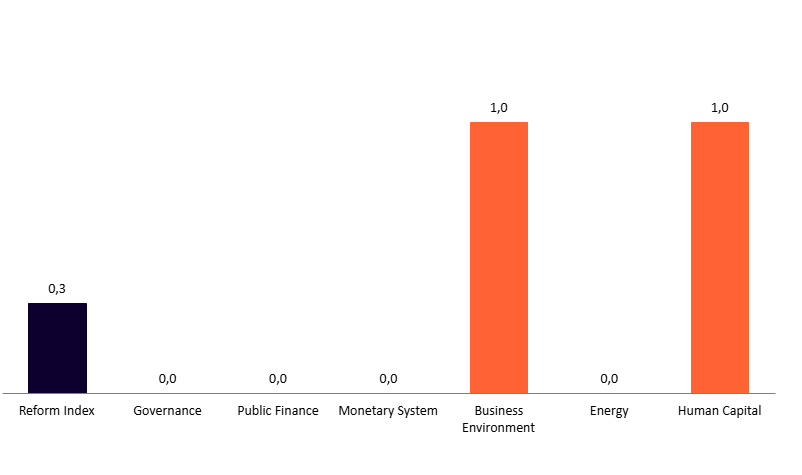The 256th round of the Reform Index, covering the period from January 13 to 26, includes six regulations — four of which focus on reforms in the area of Human Capital. The remaining two change the rules of the game in the Business Environment: an updated mineral resource development program until 2030 and a new law on state regulation of plant protection. These two regulations received the highest expert scores. The overall Reform Index score is +0.3 points, down from +1 point in each of the previous two issues.
Graph 1. Dynamics of the Reform Index

Graph 2. Values of the Reform Index and its Components in the Current Assessment Round

Updated subsoil development program, +2 points
Law No. 4154-IX updates Ukraine’s Nationwide Program for the Development of Mineral Resource Base until 2030, originally adopted in 2011. The revised program is one of the key pillars of Ukraine’s recovery under the Ukraine Facility initiative.
The law introduces a new classification of minerals into strategic (those crucial for national economic development) and critical (essential for development and in short supply). The Cabinet of Ministers will approve the official list of such minerals and their extraction sites. Extraction rights will be granted through auctions. Eligible participants include Ukrainian citizens, residents and citizens of OECD member states, and countries that have signed mineral cooperation agreements with Ukraine (e.g., EU countries and the United States). Enterprises registered in Ukraine, OECD member states, or partner countries where Ukraine or a partner state holds a significant ownership stake are also eligible—as are legal entities whose ultimate beneficiaries are Ukrainian citizens or residents of partner countries.
In addition, a dedicated state fund will be established to finance the restoration and expansion of Ukraine’s mineral resource base — including the exploration and further appraisal of promising deposits. The fund will be financed through proceeds from the sale of extraction permits and subsoil use taxes for resources of national significance.
Information about the Reforms Index project, the list of Index experts and the database of the regulations assessed are available here.
Expert commentary
Roman Nitsovych, DiXi Group
“The state needs to clearly define its strategy for meeting the economy’s demand for mineral resources. While the previous focus was on energy carriers—particularly oil and gas—current policy is shifting toward minerals of strategic and critical importance.
The updated Mineral Resource Base Development Program introduces definitions and sets out the procedure for identifying and approving the list of subsoil areas to be allocated via e-auctions or production sharing agreement (PSA) tenders. A significant feature is the formal preference given to investors from OECD member states and other countries with which Ukraine has signed partnership agreements or memoranda.
The law also establishes clear mechanisms for state funding of geological exploration aimed at increasing proven reserves. Notably, 34% of the projected state budget allocation is earmarked for expanding resources and reserves of metallic minerals.
Adopting this law is one of the benchmarks for implementing the Ukraine’s Plan under the Ukraine Facility.”
Law on State Regulation of Plant Protection, +1.5 points
The EU integration-oriented Law on State Regulation of Plant Protection aligns Ukrainian legislation with European standards. Under the new rules, plants listed in the law and intended for sale or other commercial use may only be transported within Ukraine if accompanied by a passport confirming they are free of pests. These passports will be issued by phytosanitary inspectors or authorized professional operators based on inspection results.
The law introduces new control mechanisms for the circulation of plant protection products. Each product must be labeled with a unique code to ensure full traceability — from manufacturing to use and the disposal of its packaging. Only specialists listed in the State Register of Persons Authorized to Operate in the Field of Plant Protection will be permitted to market these substances, conduct training on their safe handling, or inspect the equipment used for their application. Registration requires direct involvement in the storage or use of such products, as well as a certificate confirming completion of relevant training.
In addition, two more registers will be established: one for professional operators involved in the circulation of plants and another for laboratories operating in the plant protection sector.
Expert commentary
Hanna Kashyrina, Coordinator of the Crop Protection and Seeds Committee at UCAB
“Law No. 4147-IX introduces comprehensive reforms aimed at strengthening phytosanitary control and regulating the circulation of plant protection products (PPPs) in alignment with European standards. The law will come into effect three years after its official publication, with the exception of certain provisions that will apply immediately.
Key provisions of the law include:
- The introduction of a European-style traceability system for the circulation of plants, plant-based products, and PPPs — covering all stages from importation into Ukraine’s customs territory to end use by agricultural producers.
- Enhanced oversight of PPP circulation and use, including mandatory training on safe handling, a system for advance notification of PPP application, required technical inspections of application equipment, and detailed record-keeping and reporting.
- The delegation of specific responsibilities to private-sector entities, including the issuance of plant passports, labeling packaging materials, delivery of training on PPP handling, and technical inspections. This is expected to streamline and improve procedural efficiency.
- The adoption of a risk-based approach to state oversight in the plant protection sector, enabling more efficient allocation of resources and greater focus on high-risk areas of phytosanitary safety.
Implementing these innovations is expected to enhance the effectiveness of phytosanitary control, ensure the safe handling of PPPs, bring Ukrainian legislation into closer alignment with EU norms, and improve the competitiveness of domestic agricultural products on international markets.”
Reform Index from VoxUkraine aims to provide a comprehensive assessment of reform efforts by Ukraine’s authorities. The Index is based on expert assessments of changes in the regulatory environment in six areas: Governance, Public Finance, Monetary system, Business Environment, Energy, Human Capital. Information about the Reforms Index project, the list of Index experts and the database of the regulations assessed are available here.
Attention
The author doesn`t work for, consult to, own shares in or receive funding from any company or organization that would benefit from this article, and have no relevant affiliations



